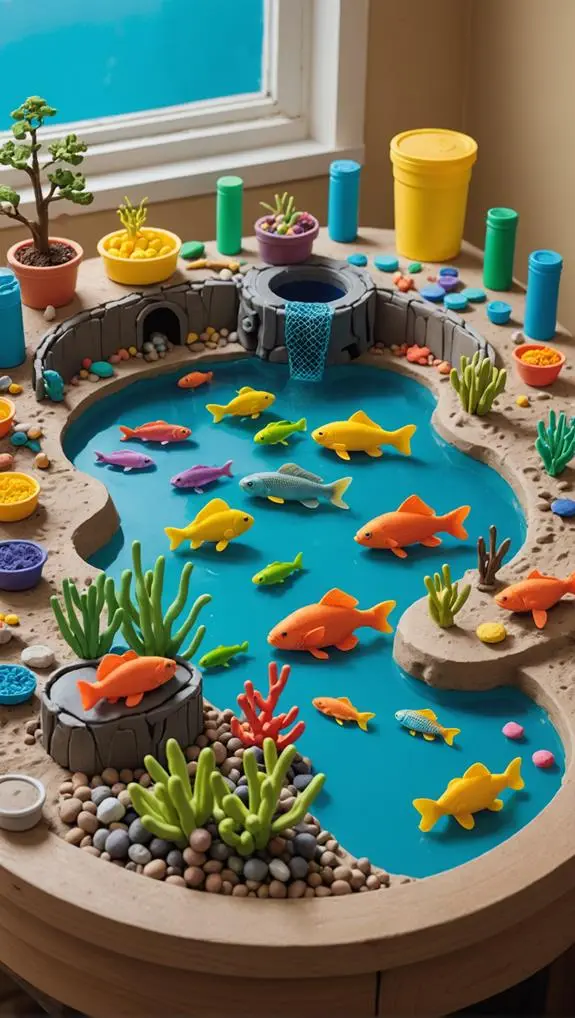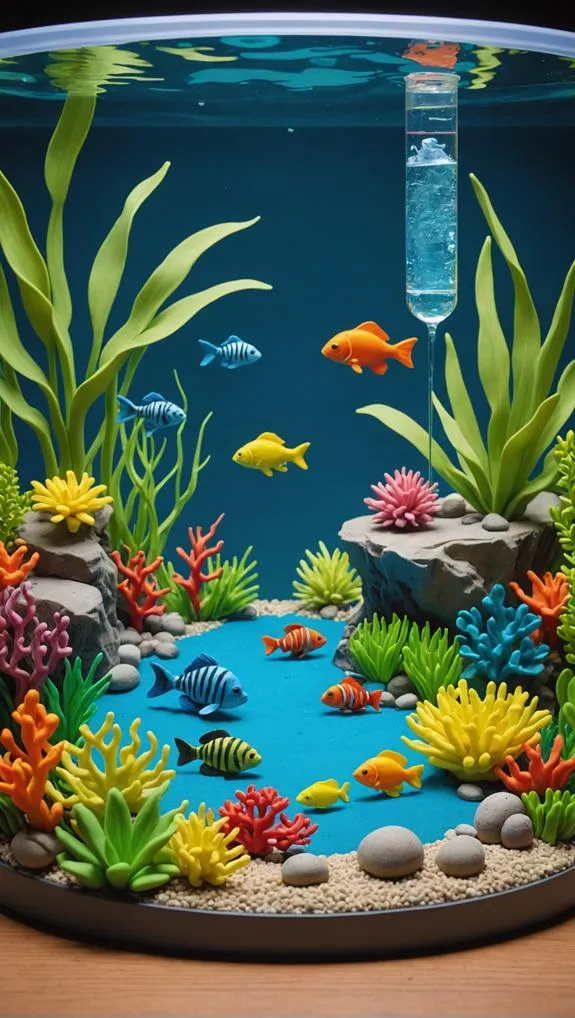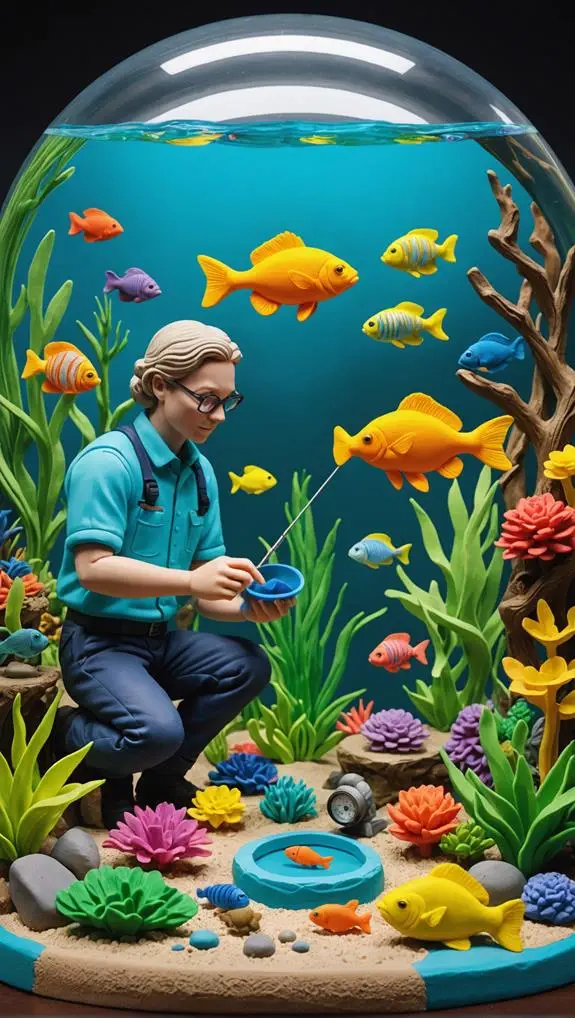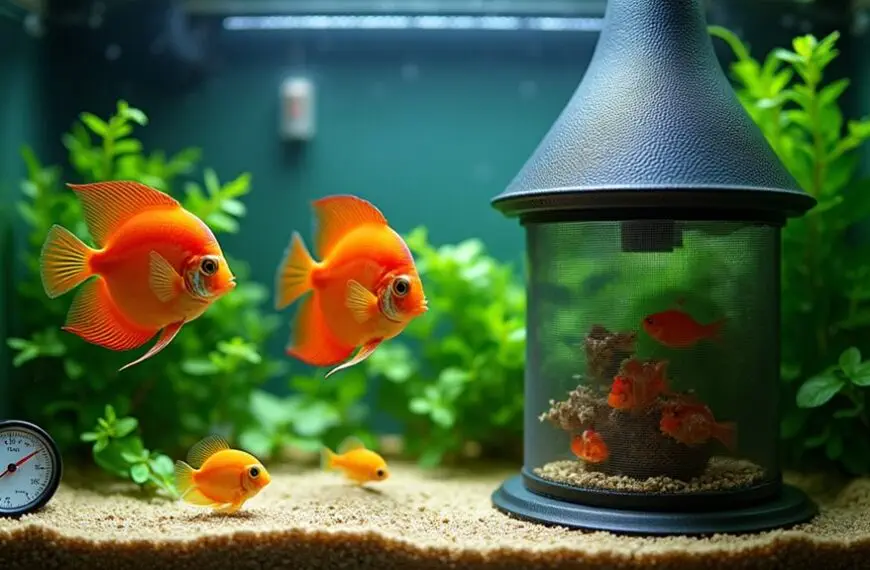If you want to succeed at breeding freshwater fish, focus on creating a comfortable environment. Start by maintaining water quality—regularly check your ammonia and pH levels. Next, pick hardy fish like guppies or platies, ensuring you have a good mix of genders. Don't forget to provide cozy hiding spots to reduce stress. A high-protein diet helps too! When your fish finally spawn, keep an eye on the little ones; they'll need lots of food and clean water. Follow these tips, and you'll be swimming in success! Stick around; there's more fishy fun ahead!
Contents
Aquarium Maintenance Essentials
When you're setting up your aquarium for breeding freshwater fish, maintaining a stable environment is crucial from the start. You'll want to keep an eye on water quality, as this can make or break your breeding success. Regular water tests are a must; checking ammonia, nitrate, and pH levels ensures they're right for your fish species. Additionally, managing essential water parameters will help prevent stress and support successful breeding.
Don't forget about water changes! Implementing partial changes weekly helps remove waste and toxins that can harm your fish. Keeping the water temperature consistent also plays a key role, so invest in a good heater and thermometer to avoid wild fluctuations.
Adding a biological filtration system can foster beneficial bacteria, which breaks down harmful substances—think of it as a helpful little army keeping your tank clean!
And if you're feeling adventurous, consider adding apple snails or other detritivores. They're like your tank's clean-up crew, munching on debris and keeping things tidy as fry emerge.
Lastly, keep detailed logs of your breeding conditions. Documenting water chemistry and species behavior will help refine your breeding habits for even better results next time.
Happy fish-keeping!
Breeding Dynamics Explained
When you're ready to tackle breeding dynamics, it's all about picking the right fish and keeping the peace in your tank.
You'll want to choose target fish like zebra danios to spark interest without causing chaos, and adding some peaceful dither fish can really help calm any nerves.
Additionally, selecting hardy species such as Guppies and Platies can enhance your breeding success due to their resilient nature.
Plus, keeping an eye on how your fish interact can save you a lot of stress—and who doesn't want a drama-free aquarium, right?
Target Fish Selection Strategies
Selecting the right target fish can significantly influence the breeding dynamics in your aquarium. It's essential to choose species that won't cause stress and aggression among your breeding pair.
Think of your fish like a family—everyone needs to get along for harmony to thrive!
When introducing target fish, do it slowly and keep a watchful eye on their interactions. You want to encourage spawning behaviors, especially as spring rolls around, but if you notice any signs of aggression, it might be time to play matchmaker and separate them into another tank.
Trust me, a peaceful environment is key to successful breeding.
Consider using dither fish, like zebra danios, to help stimulate those shy, territorial species. They can create a calming presence while nudging your breeding pair into action.
Just remember, the goal is to promote a friendly atmosphere, so ensure the target fish aren't a threat to anyone in the tank.
With the right selection, you'll be on your way to witnessing the beautiful cycle of life in your aquarium.
Happy breeding!
Introducing Dither Fish
Introducing dither fish into your breeding tank can make a significant difference in the overall dynamics of your aquarium.
These peaceful, midwater species serve an important role by helping to reduce stress among your breeding fish. By diverting aggression and creating a more secure environment, dither fish can really encourage your breeding fish to feel confident enough to spawn.
When choosing dither fish, opt for calm varieties that won't add to your breeding fish's stress. Hyperactive or aggressive species can create chaos instead of comfort.
Popular options like zebra danios or other gentle community fish can coexist harmoniously with your breeding pair.
As you introduce these dither fish, take a moment to observe how they interact with your breeding fish. This will give you valuable insights into their comfort levels.
If your breeding fish seem more relaxed and start displaying spawning behaviors, you know you're on the right track!
Managing Aggression Dynamics
Adding dither fish to your breeding tank can significantly alter the aggression dynamics among your fish. These friendly little guys, like zebra danios, calm your nervous breeding pairs and help reduce overall aggression.
By creating a more relaxed atmosphere, you're encouraging healthy breeding behavior.
When introducing your target fish, be sure to monitor their interactions. You want to stimulate breeding without triggering stress or aggression.
If things start to heat up, don't hesitate to separate the fish with a glass partition or move them to a different tank for a bit. It's like giving them a timeout—sometimes, a little space can work wonders!
Just remember, not all dither fish are suitable. Avoid hyperactive or aggressive species, as they can ramp up stress levels instead of easing them.
It's all about keeping that peaceful vibe! Observing how the dither fish interact with your breeding pairs is crucial. You want to ensure everyone feels comfortable, so the magic of reproduction can unfold.
With a little patience and the right approach, you'll create a thriving environment where your fish can flourish and breed successfully.
Happy fishkeeping!
Reducing Stress in Fish

When you're trying to breed fish, keeping stress levels low is key to success. Choosing the right dither fish can help create a calm environment, as species like tetras and rasboras thrive in groups, providing a sense of security for your breeding fish.
Don't forget to provide plenty of hiding spots for your breeding fish to retreat to when they need a break. Additionally, maintaining optimal tank conditions, such as a temperature between 74-82°F and a pH of 6.0-7.8, can significantly reduce stress and promote healthier breeding behaviors optimal tank conditions.
Plus, keeping a close eye on how your fish interact can make all the difference in encouraging those natural breeding behaviors—we want happy fish, after all!
Dither Fish Selection
Choosing the right dither fish can significantly reduce stress in your breeding tank.
These peaceful little swimmers, like zebra danios or tetras, act as a calming presence for more timid breeding fish. When they dash about in open water, they create a sense of safety, which can help reduce aggression in territorial species, like cichlids.
However, you've gotta be careful! Hyperactive or aggressive dither fish can cause more stress than they alleviate. You want your breeding fish to feel at ease, not like they're in a fishy version of a horror movie.
Environmental Safety Measures
Creating a stress-free environment for your breeding fish is key to their success. When adult fish feel secure, they're more likely to thrive and breed. One great way to boost their comfort is by introducing dither fish, like peaceful midwater species. These little buddies can help create a sense of security, making your breeding fish feel right at home.
You also want to ensure there are plenty of hiding spots. Think caves and dense plants—these cozy nooks can minimize aggression and encourage natural behaviors. Trust me, your fish will thank you!
Maintaining stable water conditions is crucial. Sudden changes in temperature, pH, or hardness can stress them out. Regular water changes and efficient filtration are essential for keeping high water quality, reducing health issues for both adult fish and their fry.
And don't forget to observe how your fish interact. This can give you clues about their comfort levels. If things seem tense, adjusting your tank's stocking can help create a more relaxed environment.
Monitoring Interactions Closely
Monitoring your fish interactions closely is essential for reducing stress and promoting successful breeding. To create a peaceful breeding environment, consider adding dither fish—these are gentle midwater species that help nervous fish feel secure. Just think of them as the friendly neighbors that keep the peace!
Keep an eye out for stress indicators like hiding, lethargy, or aggressive behavior. If you see these signs, it might be time to rethink your tank mates or conditions. When choosing dither fish, avoid hyperactive or aggressive species; you don't want to add more stress to your breeding pair.
Also, make sure your breeding environment has plenty of hiding places, like plants or caves. These safe zones can help spawning fish relax and feel more at home.
Regularly observe and document your fish's behavior. This not only helps you gauge their comfort levels but also makes it easier to catch any stress-related issues early on.
Raising Healthy Fry
Raising healthy fry is crucial for a thriving aquarium, and it all starts with their immediate needs after hatching. Newly hatched fry are tiny and need access to infusoria right away. You can cultivate this nutritious food by simply decomposing lettuce leaves in the spawning tank. Trust me, it's easier than it sounds!
To keep your fry growing strong, you'll want to feed them at least six times daily. That may sound like a lot, but fry are like little eating machines! Just be sure to keep an eye on water quality. Regular water changes and monitoring ammonia, nitrite, and pH levels are vital for their development. Remember, healthy water equals healthy fry!
Avoid overcrowding, as it can stress your little swimmers and stunt their growth. Make sure they've enough space to thrive.
As they grow, slowly introduce powdered foods and specialized fry formulas. You can also mix in some hardboiled egg yolk paste for an extra nutritional boost.
Valuable Breeding Resources

Successful breeding relies heavily on accessing valuable resources that provide insights and guidance tailored to your specific fish species. To get started, dive into comprehensive articles on the breeding habits of tropical fish like angelfish and goldfish. These guides help you understand their unique requirements.
Don't forget to review aquarium setup guides; they're crucial for effective fry rearing. Trust me, the right conditions can make all the difference in growth and development!
Want to avoid common pitfalls? Explore resources that address breeding failures and how to prevent them. This knowledge will boost your success rates and save you some head-scratching moments.
Joining community forums is another great way to gather breeding tips. Sharing experiences with fellow breeders can be both enlightening and entertaining. Plus, you'll find camaraderie in tackling unique challenges together.
Lastly, don't underestimate the importance of breeding tank maintenance. Familiarize yourself with essential tools and equipment management. Keeping your breeding environment in check will set you up for a successful journey.
Breeding Conditions and Techniques
Creating the right breeding conditions is crucial for encouraging your fish to spawn successfully. Understanding what your specific fish species need can make all the difference. Here are three key tips to set the stage for a thriving breeding environment:
- Temperature and Water Adjustments: Aim for a warm water temperature between 78-82°F. Each species has its own preferences, so do a little homework!
- High-Protein Diet: Feed your breeding pairs high-protein food three times a day. This helps condition them, getting them ready for the big moment—spawning.
- Separate Spawning Tank: Set up a dedicated tank with the right substrate and decor. This protects the eggs from hungry tank mates and makes your fish feel safe and secure.
Don't forget about dither fish! They can help shy egg scatterers feel more confident, encouraging a stimulating environment for spawning.
Once the fry hatch, be prepared with appropriate fry food to ensure they thrive.
With the right breeding conditions and some patience, you'll be on your way to enjoying the beauty of new life in your aquarium!
Water Quality Importance

How can you ensure your fish thrive during breeding? The answer lies in maintaining excellent water quality in your breeding aquarium. High water quality is crucial, as it prevents stress and disease, which can negatively affect your fish's reproductive behaviors and the health of their fry.
Regularly test your water for pH levels, ammonia, nitrites, and nitrates. Most freshwater fish prefer a pH between 6.5 and 7.5, but African cichlids like it a bit higher.
Don't forget to change your water frequently—aim for 10-25% weekly. This helps dilute toxins and adds essential minerals your fish need. A high-quality filtration system, like a sponge filter, can work wonders too. It supports beneficial bacteria that break down waste, keeping your aquarium clean and healthy.
Also, keep the temperature stable, typically between 75-82°F for most species. Sudden changes can stress your fish and ruin their chances of successful spawning.
Think of it this way: your fish are like guests at a party. If the music's too loud or the snacks are stale, they won't stick around for long! Happy fish make for happy breeding.
Fry Care and Feeding
Caring for newly hatched fry is crucial for their survival and growth. These tiny fish depend on your support to thrive, and getting their care right can feel like nurturing little miracles.
Here are some essential tips for feeding and caring for your fry:
- First Meals: Start by providing infusoria, which you can cultivate using decomposing lettuce leaves in the spawning tank. Just remember to swap out those old leaves weekly!
- Feeding Schedule: Fry need to be fed at least six times a day to ensure they receive enough nutrition during this critical growth phase. Yes, it sounds like a lot, but they'll appreciate your dedication!
- Diet Expansion: After the first week, introduce powdered foods and even hardboiled egg yolk paste. This variety will help support their development as they continue to grow.
Always keep an eye on water quality with regular changes to avoid stress and overcrowding in the fry rearing tank.
A little space goes a long way in promoting healthy growth and reducing competition for food. With your care, those fry will flourish into vibrant fish!
Monitoring Fish Health

Monitoring your fish's health is vital to maintaining a thriving aquarium. As a responsible fish keeper, you'll want to regularly assess your fish for any signs of illness. Look for changes in behavior, appearance, or even eating habits—these can be early indicators of health issues.
It's equally important to implement a routine for checking water parameters like ammonia, nitrite, nitrate, and pH levels. Keeping these in check helps create optimal conditions, reducing stress and the risk of disease.
For breeding pairs, pay special attention before and after spawning, as this can be physically taxing. Providing extra nutritional support during this period can make a world of difference.
If you're introducing new or sick fish, quarantine them for at least 2-4 weeks. This simple step can save your entire aquarium community from potential outbreaks.
Also, keep an eye out for common health issues like fin rot or swim bladder disease. Address these swiftly to prevent mortality among your precious breeding fish and fry.
Frequently Asked Questions
How to Encourage Fish to Breed?
To encourage fish to breed, adjust water temperature for optimal breeding conditions, ensure proper tank spacing for comfort, and enhance feeding habits with a high-protein diet, stimulating their natural instincts to spawn effectively.
What Are the Breeding Strategies of Fish?
When you explore breeding strategies, you'll discover fish exhibit incredible spawning behaviors, from meticulous parental care to unique breeding environments. Genetic selection plays a key role, ensuring vibrant, thriving populations that amaze and inspire everyone around.
How Profitable Is Fish Breeding?
Fish breeding can be challenging in terms of profitability. Conduct a cost analysis, focus on species selection based on market demand, and prioritize breeding success to enhance your chances of covering costs and generating income.
What's the Easiest Freshwater Fish to Breed?
If you're looking for the easiest freshwater fish to breed, consider guppies. They require minimal guppy care, unlike betta fish or angelfish pairing. Neon tetras are also simple but less prolific. Enjoy your breeding journey!
Final Thoughts
Breeding freshwater fish can feel like a dance. Just like a well-choreographed routine, it takes practice, patience, and a bit of grace. Remember, starting with a clean tank and maintaining water quality is like setting the stage for a great performance. As you nurture your fish and watch fry grow, you're not just raising fish; you're creating a vibrant underwater community. So, dive in with enthusiasm, and enjoy every splash along the way—your fishy friends will thank you!












